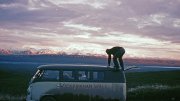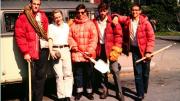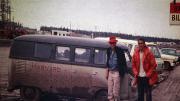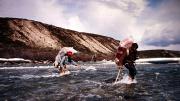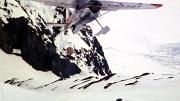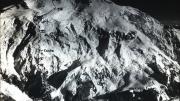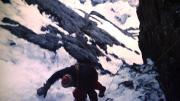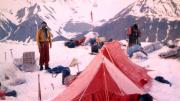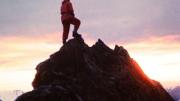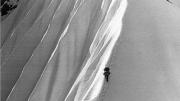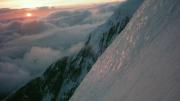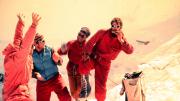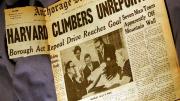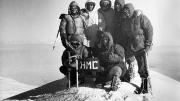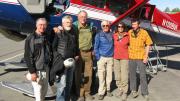In June 1963, seven Harvard mountain climbers—new graduates Hank Abrons ’63 and Rick Millikan ’63, along with Peter Carman ’64, John Graham ’64, Don Jensen ’65, David Roberts ’65, and graduate student Chris Goetze ’61, [Ph.D. ’70,] (at 23 the “old man” of the group)—set out to conquer a previously unscaled mountain face bigger than any on Everest. John Graham recalls their adventure and reports on the return trip he made with Carmen, Millikan, and Roberts this past June to celebrate the fiftieth anniversary of a climb that still has not been repeated.
There was no sound as blocks of ice the size of trucks broke off cliffs at 14,000 feet and came crashing 9,000 feet down the north face of Mount McKinley, called the Wickersham Wall. Only when the avalanches smashed into a bowl near the mountain’s base did we hear the booms. A few moments later, ice storms kicked up by the impacts shook our tents, pitched a half-mile away. Then it was quiet and the seven of us—all climbers from the Harvard Mountaineering Club—looked up at the mammoth rampart of ice and rock in front of us and understood the task we’d taken on. The Wickersham Wall of Mount McKinley (now Denali) in Alaska rose from the Peters Glacier, where we’d placed our base camp at 5,350 feet, to the north summit at 19,470 feet. This made it, top to bottom, the second highest mountain face in the world, bigger than anything on Everest. In June 1963, it had never been climbed. The avalanches suggested why; any route up the face had to cross directly in their path.
We were all experienced climbers, even if Hank Abrons was the only one of us who had ever been on a big mountain expedition before. We’d learned on rock cliffs around New England and in the icy gullies of Mount Washington, in New Hampshire, where fierce storms had prepared us for the weather on McKinley, the coldest mountain on earth.
On June 18, we parked our VW Microbus 30 miles north of the mountain, as close as we could get by road, strapped on 70-pound packs, and started a three-day trek across the tundra to base camp, where we would wait four days for an airdrop of more supplies. We used the respite to carefully plot the timing and path of the avalanches; there were daily “windows” when most of the avalanches fell: the ice blocks at 14,000 feet loosened when the sunlight was most direct.
Our route, suggested by Brad Washburn ’33,[L.H.D.’75,] one of the finest mountain cartographers in the world, led straight up the Wickersham Wall. Brad’s detailed photos showed a shallow ridge or buttress that snaked vertically up the face; he thought it would provide protection from the avalanches, which would bounce off it on either side. He was right—mostly. We discovered only when we got to base camp that his protective buttress did not extend quite to the base of the mountain. The only way to reach it was to climb 1,200 feet up an “icefall” of tumbled ice towers and blocks—squarely into the path of the avalanches—and then dash as quickly as we could out of harm’s way to the left.
It all seemed then like the grand adventure it turned out to be. We discounted the dangers, even though there were close calls. Because the full climb would take more than a month, we each had to make five trips up that icefall hauling food and gear, playing Russian roulette every time. Just above the icefall, the danger was falling rocks. Climbing with Dave, I was once caught in the open as a cascade of rocks came straight at me from a cliff to my left. A rock the size of a basketball all but parted my hair. Dave and I laughed and hurried on.
We were a bargain-basement bunch. Much of our clothing and gear came from army surplus. We made more of it ourselves, including tents designed and sewn by Chris that were a match for the worst that McKinley could throw at them. We made snowshoes by bending aluminum tubing from the hardware store and crisscrossing it with nylon cord. The only pricey gear we had was down sleeping bags and leather climbing boots. We didn’t have the cash for a radio, which we thought too heavy to carry in any case (once we were launched on the mountain we were on our own). We carefully planned and packed meals, testing weight, calories, and cost. We bought a used Microbus that carried 2,000 pounds of food and gear to Alaska along with four of us. The total expedition cost for all seven of us was $2,850.
It never gets dark in midsummer Alaska, so for the whole first half of the expedition, we climbed “at night” when there was no direct sunlight to soften the snow and make footing more treacherous. On June 30, we crossed the avalanche chute for the last time and breathed a sigh of relief. We split the work. We rotated the plum job of route finding: a new pair went out every night, without packs, to explore a route up, cutting steps in the steep ice where necessary and fastening fixed ropes to the ice or rock that could then be used by the others, who ferried loads up from lower camps.
Above Camp One, when an icy rock cliff proved too difficult to climb carrying loads, we rigged a 350-foot pulley system using hemp ropes and Purina feed sacks and in one night hauled all our supplies to the top of the cliff. For the next nine days we carefully picked our way up and around rock and ice cliffs, crevasses, and leaning ice towers called seracs, heading for the line of ice cliffs at 14,000 feet that spawned the avalanches. To cross one deep gulley, we used a rope ladder with aluminum steps fashioned from hardware-store supplies.
On July 8, we found a crack in the ice cliffs at 14,000 and climbed up through it. Now all that was left was a smooth 35- to 40-degree snow slope leading straight to the north summit, 5,470 feet above. We pitched Camp Nine at 17,400 feet, hacking out tent platforms in the hard snow. There, a four-day blizzard pinned us in our tents.
July 16 dawned clear and almost windless. We struck our tents and headed for the north summit. Halfway there, the weather began to worsen again. Deep snow and thin air made each step an enormous effort. By 1 p.m. we were only a few hundred feet from the top, but battling 55-mile-an-hour winds and temperatures well below zero. Often we were forced by the winds to our hands and knees to keep from being blown off the mountain.
Finally there was no more “up;” we’d reached McKinley’s north summit. Three days of easy going later we reached the south summit, at 20,320 feet. It had taken us a month to go up the mountain from the north; it would take us only two days to come down, taking the easy route on the other side, then circling around the mountain to our original base camp. In two more days, when we reached the McKinley River, we could see our bus on the far bank, a half-mile away.
The water level in rivers like the McKinley varies dramatically, depending on the time of day. Sunlight had hit the north side of the mountain in the morning, melting the snow and ice. That evening, the meltwater was roaring past us in full flood. There’s a prime directive in crossing dangerous, glacier-fed rivers—wait until low water. But that would have required patience we did not have. We roped up and headed across.
Hank and I were the last rope team to reach the final braid of the river. He plunged in and was just reaching the far bank when I started. At once I stepped into a hole the others had somehow missed, lost my balance, and was dragged under. Tons of fast-moving water pummeled me against rocks on the stream bottom. Swimming was impossible. Hank was pulled off his feet by the rope that joined us, and was being dragged backward across the gravel toward the flood. The others were too far away to help in time. In the next 30 seconds, either the pull of the rope would pendulum me onto the far bank, or the force of the river propelling me downstream would pull Hank in, too, and we both would drown.
Hank spread-eagled himself on the bank, desperately trying to resist the pull of the rope, but there was nothing to hold on to and he was pulled foot by foot closer to the edge. I was helpless, one moment smashed against the rocks on the river bottom, then up, gasping for air.
I hit the far bank seconds before Hank was dragged the final few feet into the river. Moments later, the others pulled us both to safety. When we got to the bus, we found that someone had changed the “Harvard” taped on its side to “Yale.”
Next day, we reached the McKinley Park Hotel to collect on a bet: the hotel manager had made a public wager that if the Harvard team climbed the north wall and lived to tell about it, he would treat us to all the steak dinners we could eat. The meal turned out to be even more dramatic than we’d expected. Unbeknownst to us, three weeks before, a bush pilot had reported seeing our tracks disappear into avalanche debris, and “Harvard Climbers Missing” had turned up on front pages all over the country. Hopes for us had “dimmed” when that four-day storm had hidden our tents, just beneath the north summit, from view. Once the storm cleared, our tents were sighted, but good news travels more slowly than bad. When the seven of us tramped into the dining room of the hotel—gaunt, unshaven, red-eyed, sunburned—a few astonished patrons looked at us as if we’d returned from the dead—a reaction duplicated by more than a few friends in Cambridge that fall.
That hotel burned down years ago, so there was no chance for a reprise dinner this past June. As another part of our reunion, however, the four of us hired a bush pilot to fly us by the Wall. There was remarkably little talk as we stared at the massive face, its cliffs and towers looking as fearsome as we’d found them 50 years before.
Reminiscing over beers with my HMC buddies, we all agreed that our 1963 climb had “worked” in part because of how smoothly we’d functioned together as a team of equals. And we were all delighted that the camaraderie that had supported us so well 50 years ago reappeared, it seemed, in minutes, even though some of us had not seen each other in decades. Our only sorrow was the absence of Hank, Chris, and Don. Hank simply couldn’t make the trip and Chris and Don had both died young, but neither one from mountaineering.
The “Harvard Route” is a well-known climb, especially in Alaska, so the halls were full in Anchorage, Talkeetna and Wonder Lake for the public presentations we gave there of our 1963 slides. At the Q&As, one question kept coming up: “Did this experience change your lives—and how?” All of us agreed that those intense and dangerous 36 days had helped shape the meaning of the life experiences that would follow. For Dave Roberts, it would launch a career as an adventure writer. For me, it would lead to a lifetime of taking risks, many of them in the U.S. Foreign Service. For all of us, it had been a rite of passage.
Jon Krakauer, in Eiger Dreams, describes the “Harvard Route” up the Wickersham Wall as a climb “so bold or foolish…that it still hasn’t been repeated.” At least one person has died trying. Recalling the dangers, the technical challenges, the massive physical effort over weeks—and, yes, in retrospect, the need for luck—I think we all marveled that we did it. I know that we will always be proud that we did.
